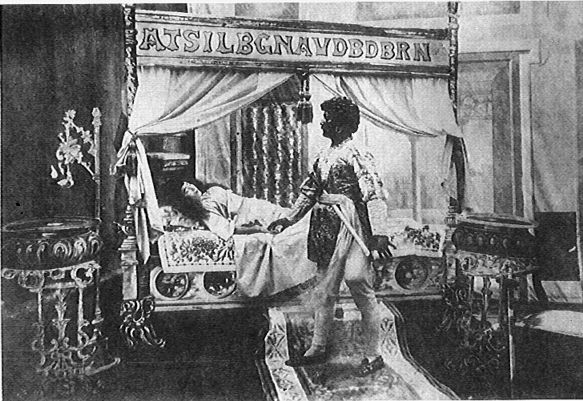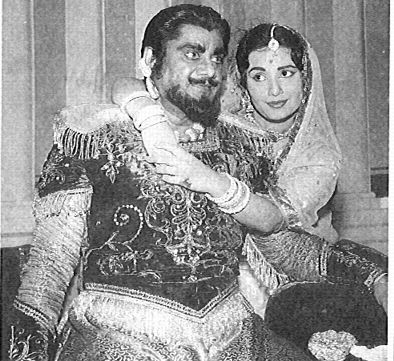Shakespeare in India (5)
Shakespeare in India -- page 5
Shakespeare on the early modern Indian stage
(Note: In the Indian context, 'early modern' indicates the 19th and early 20th centuries. The precise period in question will differ from one region or language to another.)
As stated above, the first language to illustrate this total model of 'Shakespearean' development was Bengali. The earliest recorded public production of Shakespeare in Bengali was of a version of The Comedy of Errors in 1873 about which little is known. The next year saw adaptations of Cymbeline and Macbeth, and the following year of Othello. In 1893 came a distinguished Macbeth by Girish Chandra Ghosh, the doyen of Bengali theatre in his day. A masterpiece of poetic translation, it flopped on the stage, to Ghosh's mortification - which may have increased when in 1897, Nagendra Nath Chaudhuri's Hariraj, a much cruder version of Hamlet, appeared to great applause and held the stage for years.
Except for Ghosh's Macbeth, all these plays - like versions of the Dream, the Merchant, Measure for Measure and another Othello - were free Indianized adaptations, often transforming the plot and adding new wealth of rhetoric, song and melodrama. (A Cleopatra of 1914 added a dash of Shakespeare to a plot chiefly indebted to Rider Haggard.) The public would have seen such plays as outcrops of the general run of poetic melodrama and tragic-heroic numbers. The Shakespearean roots of the formula itself might have been appreciated only by a few.

Othello prepares to kill Desdemona: Bengali Othello, Star Theatre, Kolkata, 1919. Translated by Debendranath Basu. Taraknath Palit as
Othello, Tarasundari as Desdemona.
From various starting dates, much the same trajectory can be traced in many Indian languages. In fact, Shakespearean adaptations often predate and outnumber the Bengali, though the total growth of the theatre on the Shakespearean model is later or more sparse. In Gujarati, for instance, a version of The Taming of the Shrew was acted at Surat as early as 1852. Its tenor is brought out by the title, which translates as 'How a bad Firangee (European) woman was brought to her senses'. Shortly after, Ranchhodbhai Udayram played the pioneer in translating and performing Shakespeare in Gujarati under the aegis of the Shakespeare Kathasamaj (Literary Society). A 1903 Gujarati Othello became so popular that the male actor playing Desdemona adopted 'Sundari', the heroine's name in this version, as his permanent stage name.
The neighbouring language of Marathi saw about 65 versions of Shakespeare - chiefly free adaptations - between 1867 and 1915, starting with a popular version of Othello composed by Mahadevshastri Kolhatkar and acted by the Aryaddharak Natak Mandali. The ubiquitous natak mandalis or theatre groups established Shakespeare on the Marathi stage. The greatest contribution came from the Shahu Nagarwasi Natak Mandali steered by Ganapatrao Joshi, the so-called 'Garrick of Maharashtra', with his celebrated renditions of Hamlet, Othello and Macbeth; and the Victoria Natak Mandali, which began its career with a version of Much Ado and took its repertoire abroad to both east and west. 'The Marathi stage,' said the legendary theatreperson B.V. Warerkar, 'was more or less inundated with Shakespeare.' [8] There were even musical versions of A Winter's Tale and Measure for Measure, following the local tradition of musical drama (sangeet natak). Many Marathi versions of Shakespeare became classics in their own right, and the line continued later and more abundantly than elsewhere. The most lasting success was Zunzarrao, G.B. Deval's 1890 adaptation of Othello, revived even in the 1950s. But as with Bengali, Shakespeare's greatest gift to Marathi theatre was to provide a general model for the larger body of drama.

A scene from a mid-20th-century production of Zunzarrao, the classic Marathi version
of Othello. Featuring Baburao Pendharkar as Othello and Jeevankala as Desdemona.
There was abundant Shakespearean fare in most southern states as well. Beginning with a Merchant in 1870, at least 30 Shakespeare adaptations in Tamil are said to have been performed by 1900 (including 9 of Cymbeline alone), in nearly 100 towns in Tamil Nadu (former Madras state). The writer Ka Naa Subramanyam recalls having seen at least a dozen Shakespeare plays in Tamil and English in his schooldays. [9]
In Kannada, at least 15 titles had been performed by 1929, usually in prose adaptations with some verse, beginning with an Errors in 1871. There were even freer appropriations in the 1920s - what must be regarded as original plays with a large Shakespearean infusion. The actor A.V. Varadachar ensured the success of an immensely popular version of Romeo and Juliet - just as the Tamil Shakespeare had been popularized by P. Sambanda Mudaliar.
In Telugu, an 1876 verse Julius Caesar was followed by an adaptation of Errors produced in 1880 by Kandukuri Veeresalingam, the father of modern Telugu literature, on the sets left behind by the Dharwad Dramatic Company in his home town. But as with Bengali and Marathi, the true Shakespearean legacy to Telugu theatre lay in the general dramatic model rather than specific translations or adaptations. By contrast, drama in Malayalam, the fourth chief language of the south, took relatively little from Shakespeare. There was, however, a popular Dream in 1909, improbably translated from a Sanskrit version of 1906 and adapted to the model of musical Tamil drama that was already influencing the Malayalam stage.
For the most numerous and most divergent body of Shakespearean theatre from this era, we must move northwards again to consider the so-called Parsi theatre. The Parsis, the entrepreneurial Zoroastrian community centred in Mumbai, had evinced a rare interest in Shakespeare. Their distinguished surgeon Dhanjishah Parekh was a keen amateur actor with knowledge of the London stage. Truly remarkable is the career of Jehangir Khambatta, who set out for London as a stowaway to see Shakespeare on stage, landed up in Java where he saw Othello acted by an Australian touring company, and went on to become a legendary man of the theatre.
In course of time, Parsi proprietors set up a network of theatrical companies across India. Their popular, often sensational fare, with a heady measure of music and spectacle, anticipated the modern Indian popular cinema; and like that cinema, it had its nerve-centre at Mumbai.
Parsi theatre operated in various languages: Hindi, Urdu, Gujarati - even, briefly, in English. Its playwrights numbered both Hindus and Muslims: Ahsan Lucknowi, Radheshyam Kathavachak, Aga Hashr Kashmiri (who founded the Indian Shakespeare Theatrical Company, and liked to be called 'the Indian Shakespeare'), Narayan Prasad Betab (who ran a magazine called Shakespeare to publish his versions), Shrikrishna Hasrab, Mahi Hasan and Tulsidas Saida. At least a dozen Shakespeare plays were put to use in the prolific, lively, adaptive, though limited and stereotyped repertoire of this theatre. Intellectuals accused them of debasing the Bard. The common audience might have been unaware of the literary origins of their lurid fare. Certainly the plays took little from Shakespeare beyond the general outlines of the plot. But all in all, the Parsi companies might have ensured the biggest and most widely circulated presence of Shakespeare ever within the Indian theatrical scene.
The Parsi theatre declined from the 1920s, though a few companies lingered on even into the 1950s. Their decline was partly due to the rise of popular cinema. Harder to explain is the marked decline, from the same period, in the Shakespearean theatrical presence in various states and languages across India. In Marathi, the 65 versions between 1867 and 1915 were followed by only two in the next 40 years. In Bengali, there seem to have been no new stage versions at all between 1919 and 1953. Tamil saw a similar sharp drop from the 1920s, as somewhat later did Telugu. Hindi theatre absorbed little Shakespeare even as the language underwent its first modern literary burgeoning.
A ready explanation would be hostility to the iconic English dramatist in the era of the Indian Freedom Movement. But the academic study, even in good measure the literary cultivation of Shakespeare, continued unabated. The answer may rather lie within the theatre. The influence of newer theatrical models - Ibsen, Shaw, later Brecht - has sometimes been cited. More generally, it may simply have been that the Shakespearean vein was exhausted. It had been crucial to the early development of modern Indian theatre. Dramatists and producers had worked their way through it, and now wanted to move on. For significant new developments, we have to wait till the era after India's independence in 1947.
previous page | table of contents | next page
Notes
[8] Cited in Oxygen News p.5 [Back]
[9] Ka Naa Subramanyam, 'Shakespeare in Tamil', Ind.Lit. p.123. [Back]
